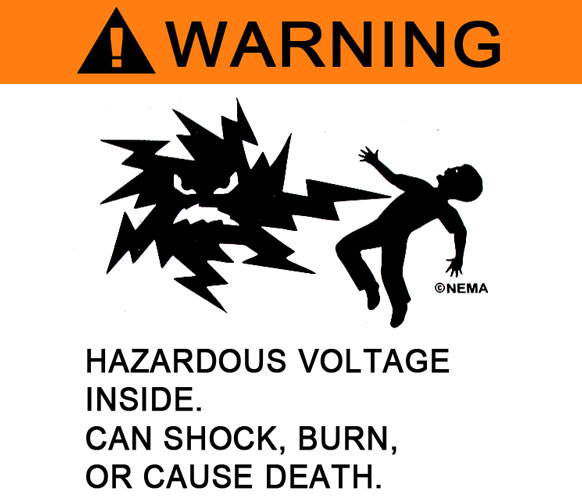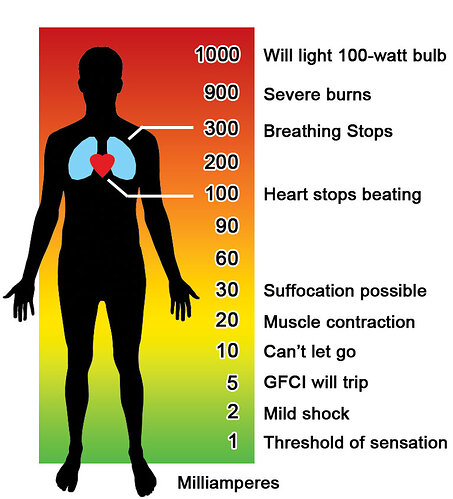
Education about the respect for electricity and safe work practices is critical in preventing injuries.
Electric shock occurs when your body becomes part of a closed circuit and electric current flows into one part of your body and out another, like into your hands and out of your feet for instance.
The effects of AC on the body depend largely on the frequency. Direct current (DC) is generally less dangerous than alternating current (AC). Low frequency currents of 50 to 60 Hz are usually more dangerous than high frequency currents.
How bad you are injured by electrical shock is determined by the pathway of the current through your body. Current traveling from arm to foot is likely to go through the heart, making it more dangerous than current traveling between a leg and ground.
Effects of electrical current on the human body
- Current flowing through the heart causes fibrillation of the heart.
- Current flowing through muscles causes contraction of the muscles.
- Current flowing through the brain causes a loss of consciousness and seizers.
In many cases, electric shock causes death. The threshold of perception for current entering the hand is about 5-10 mA for direct-current and about 1-5 mA for alternating-current at 60 hertz.
Let-Go current is the maximum amount of current that can cause your arm muscles to contract while maintaining the ability to release your hand from the current source. The let-go current varies depending on muscle mass. For DC, the let-go current is about 75 mA for a 70-kg body; for AC, it is about 15 mA.
Ventricular fibrillation occurs with currents as low as 60-100 mA in AC systems. For DC, about 300 to 500 mA.
How bad you are injured by electrical shock is determined by the pathway of the current through your body.
How to calculate current flow through the body
The human body is a good conductor of electric current simply because it is 70% water. Human tissue is very sensitive to the flow of electric current and is more susceptible to electric shock when wet.
How much current flows through a person’s body can be estimated using ohms law (I = E/R). The average resistance of a dry human body can be as high as 100,000 ohms, of course this varies from person to person depending on their body structure. When wet, the resistance may drop as low as 500 ohms depending on the voltage level.
Electrical Burns
Heating due to the resistance of the body is the cause of electrical burns. If skin resistance is low, few, if any burns will occur. If skin resistance is high, energy may be dissipated at the surface resulting in large surface burns.
Internal tissues are burned depending on their resistance; nerves, blood vessels, and muscles conduct electricity better than denser tissues like fat, tendon, and bone. Arc-flash temperatures can reach or exceed 35,000°F (19,400°C) at the source of the arc, which can result in severe burning of the skin.
Neurological Effects
Electric current can interfere with the central nervous system, especially over the heart and lungs. Severe or repeated non-lethal shocks can damage nerves, which may impair sensation, movement, and gland or organ function.
Prevention
Education about the respect for electricity and safe work practices is critical in preventing injuries from electrical shock. Any electrical device that may be touched by the body could be life threatening and should be properly grounded and protected.

